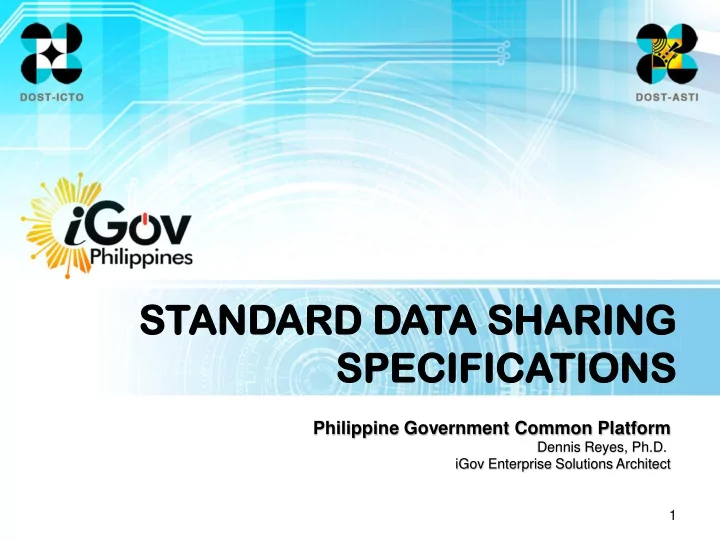

ST STAND NDARD ARD DATA SH SHARING ING SP SPEC ECIF IFICA ICATIONS TIONS Philippine Government Common Platform Dennis Reyes, Ph.D. iGov Enterprise Solutions Architect 1
OVERVIEW: GOVERNMENT COMMON PLATFORM 2
Context Of Applied Enterprise Standards EGMP (E.O. 265 | JMC 2012-01) PGEA | PGIF CLUSTER SPECIFIC DATA EXCHANGE TEMPLATE (PHIE, PBR, ETC.) CLIENTS / MEMBER ORGANIZATIONS PHILIPPINE GOVERNMENT ENTERPRISE & INTER-GOVERNMENT DATA EXCHANGE ARCHITECTURE DISASTER RECOVERY / BUSINESS MEMBER ORGANIZATION-SPECIFIC COLLABORATIVE GROUP SHARED CENTRAL REGISTRIES MANAGED ENTERPRISE DATA WAREHOUSE CONTINUITY MANAGED SYSTEMS DATA MANAGED ENVIRONMENT ENVIRONMENT MANAGED ENVIRONMENT ENVIRONMENT CLUSTER-SPECIFIC DATA MARTS CENTRALIZED ADMINISTRATION AND MANAGEMENT ENVIRONMENT TECHNOLOGY POLICY AND GOVERNANCE iGOV HIGH-SPEED NETWORK INTER-CONNECTIVITY 3
Design And Architecture Philosophy The design and architecture philosophy to standardize an enterprise architecture and an inter-governmental data sharing model is straightforward: De-couple systems; Consolidate data; Federate the distribution of data by context ; and, Secure Access to federated data repositories; The foci of the enterprise architecture will be on what will “UNIFY” and not on what will “DIFFERENTIATE”. The focus is on universality and not atomicity . 4
Technical Design Considerations The Technical Architecture and Inter-Governmental Data Sharing Model: 1. MUST employ a non-intrusive, de-coupled, asymmetric, asynchronous, service-oriented architecture (SoA) design focused on providing for “facilities” and “channels” rather than on process or applications unique to each participating member – the “ whole being greater than the sum of its parts ”; 2. MUST consist of component parts that are independently scalable and extensible vertically or horizontally or diagonally (proportional vertical and horizontal); 3. MUST provide a secure, context-relevant platform and systems environment for partners to share and exchange up-to-date structured and non-structured data; 4. MUST sustain high processing performance and low latency searches; and, 5. MUST reduce governance and management complexity by federation; 5
The Technical Architecture To reduce governance and management complexity, and to ensure highprocessing performance of the resulting enterprise system, the architecture was de-coupled and logically structured into specific managed environments: 1. Client Environment – comprised of existing and future client-side applications; 2. Collaborative Group Shared Data Environment – comprised of publication servers (push and pull services) and data marts which are designed to align with the data sharing requirements and formats of member organizations who comprise the “cluster”. Access to cluster publication servers are defined and controlled by the cluster; 3. Context Registries Environment – comprised of context registries (citizens, business, vehicles, etc.) which are accessible to the entire ecology of authenticated government users; 4. Enterprise Data Warehouse Environment – comprised of tiered repositories of data processed by ETL services that update context registries and cluster-level data marts; Access to the different environments are controlled and regulated by an Enterprise Service Bus. 6
COLLABORATIVE GROUPINGS Banking Disaster Risk Mitigation Benefits Administration Economic Competitivenes Consumer Welfare Economic Development Crime Prevention Employment (Local and Foreign) Criminal Prosecution Energy Culture and Arts Entertainment and Amusement Customs Financial Institutions Cybersecurity Food and Drugs Disaster Management Food Production Disaster Recovery Food Security 7
COLLABORATIVE GROUPINGS Foreign Affairs K-12 Education Government Communication Law Enforcement Health and Nutrition Legal Representation Services Higher Education LGU Administration History and Heritage LGU Policy Housing Livelihood Development Immigration National Boundaries Information Communication Technologies National Defense Investments (Local and Foreign) National Intelligence Judiciary Natural Resources 8
COLLABORATIVE GROUPINGS Operations Research Social Welfare Penology Sports and Athletics Development Professional Education Statistics Public Communications (Broadcasting) Telecommunication Public Infrastructure Tourism Public Safety Trade (Local and Foreign) Roads Management Transportation and Logistics Sanitation Utilities Science, Technology, and Applied Research Vocational Education Securities 9
GOVERNMENT COMMON PLATFORM TECHNICAL ARCHITECTURE ENTERPRISE DATA WAREHOUSE 10
Recommend
More recommend